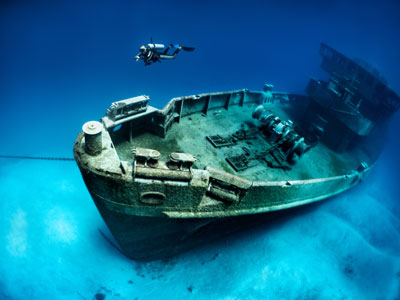We went Lionfish hunting last weekend with a friend. She’s a dive master and uses her days off to ‘go fishin’. We met at her house where she loaded up all her gear, then we drove to West Bay dock to meet the boat. Several other dive masters were already on board. It’s become a Sunday…
…tradition to spend the day Lionfish hunting. We motored out to several drop offs where dive operators have been spotting Lionfish in recent weeks. We gear up for SCUBA, grab the sling and holding tank and dive down. Our friend is especially good at catching Lionfish – she moves very slowly and is able to get very close. The sling is only 3 feet long, so the closer you get the more likely you are to get a hit. Our friend has learned that the fish don’t move if they don’t feel threatened, so she moves very slowly while they float under an overhang, and when she is within a few feet she releases the sling. She caught 23 fish that day and missed only once.
Because the spines are poisonous, the speared fish is maneuvered into the tank through a rubber gasket on one end. Once the fish is through the gasket, the catch on the sling is released and the spear is pulled out, leaving the fish inside the tank. The tank is bulky and not hydrodynamic, so usually one person uses the spear and a second person holds the tank. Sometimes the fish are too small to withstand the pronged spear – they break apart and float to the bottom where large snapper move in to eat them.
Back on shore we head back to our friend’s house where the filleting starts. It’s a tricky process to hold the fish still and removed the spines with a sharp knife. Once all the fish are de-spined they are filleted. Then they become dinner – breaded Lionfish tacos with all the fixin’s. The meat is light and flaky and has a mild taste – it’s very good eating. Our friend freezes her extra meat for later dinners. Other divers sell their catch to local restaurants where they get a cash price per pound or a higher price in dining credit. The restaurant owners love this arrangement – fresh fish straight from our reefs to create innovative dishes using a fish that essentially farms itself in the wild.
Unfortunately for the Caribbean, Lionfish are invasive and are damaging the local fish populations. The Lionfish likes to hang out in the small coral outcrops of reef fish nurseries. They are feeding on the young populations of our local fish and doing it so aggressively they are damaging local populations. We have seen small to medium sized Lionfish numerous times while swimming around Grand Cayman. The fish are even more common further offshore, and can reach large sizes (8lbs or so) in locations where they are not culled frequently. Our friend has been on Sunday dives where the group culled over 100 fish.
DNA tests done on Lionfish in Cayman and the rest of the southern Caribbean show that this invasion derived from a tank spill that occurred during Hurricane Andrew which devastated the southern tip of Florida in 1992. Captive Lionfish there were washed out to sea in the storm and took hold in the Florida environment and eventually worked their way south to other Caribbean islands. Because of their poisonous spines they have no natural predators.
Lionfish are a beautiful animal – rich colors of cream and red-brown stripes with long frilly fins and spines. For now they are a novelty for many Cayman residents, but the dive community feels threatened by the damage they are causing to the ecosystem. Most dive masters are committed to helping restore the balance by culling on their days off. And we are lucky to be friends with a dive master who has a great fish taco recipe!







